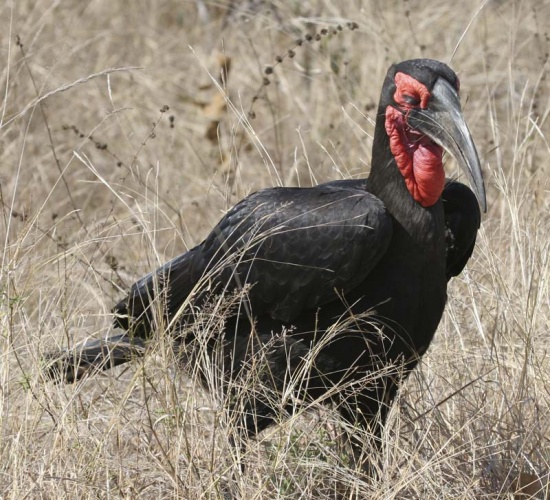| Line 2: | Line 2: | ||
[[Image:Southern_Ground-Hornbill.jpg|thumb|550px|right|Photo by TwoBoy]] | [[Image:Southern_Ground-Hornbill.jpg|thumb|550px|right|Photo by TwoBoy]] | ||
==Identification== | ==Identification== | ||
| − | |||
| − | |||
| − | |||
The Southern Ground Hornbill, Bucorvus leadbeateri or cafer, is one of two species of ground-hornbill and is the largest species of hornbill. | The Southern Ground Hornbill, Bucorvus leadbeateri or cafer, is one of two species of ground-hornbill and is the largest species of hornbill. | ||
It is a large bird, at 90 to 129 cm (36 to 51 in) long and a weight of 3.2 to 6.2 kg (7-13.6 lbs). It is characterized by black coloration and vivid red-coloured face and throat patches (yellow in juvenile birds). The white tips of the wings (primary feathers) seen in flight are another diagnostic characteristic. The beak is black, straight and presents a casque, more developed in males. Female Southern Ground Hornbills are smaller and present a blue stripe in the throat patches. | It is a large bird, at 90 to 129 cm (36 to 51 in) long and a weight of 3.2 to 6.2 kg (7-13.6 lbs). It is characterized by black coloration and vivid red-coloured face and throat patches (yellow in juvenile birds). The white tips of the wings (primary feathers) seen in flight are another diagnostic characteristic. The beak is black, straight and presents a casque, more developed in males. Female Southern Ground Hornbills are smaller and present a blue stripe in the throat patches. | ||
| + | ==Distribution== | ||
| − | + | ==Taxonomy== | |
| + | ==Habitat== | ||
| + | Its habitat comprises savannahs, woodlands and grasslands of north-east southern Africa | ||
| + | ==Behaviour== | ||
| + | The Southern Ground Hornbill is a vulnerable species, mainly confined to national reserves and national parks. They live in groups of 5 to 10 individuals including adults and juveniles. Often, neighbouring groups are engaged in aerial pursuits. They forage on ground, where they feed on reptiles, frogs, snails, insects and small mammals. Juveniles are dependent of adults for 6 to 12 months | ||
==External Links== | ==External Links== | ||
| − | + | {{GSearch|Bucorvus+leadbeateri}} | |
| + | |||
[[Category:Birds]] | [[Category:Birds]] | ||
Revision as of 17:46, 26 May 2007
- Bucorvus leadbeateri
Identification
The Southern Ground Hornbill, Bucorvus leadbeateri or cafer, is one of two species of ground-hornbill and is the largest species of hornbill.
It is a large bird, at 90 to 129 cm (36 to 51 in) long and a weight of 3.2 to 6.2 kg (7-13.6 lbs). It is characterized by black coloration and vivid red-coloured face and throat patches (yellow in juvenile birds). The white tips of the wings (primary feathers) seen in flight are another diagnostic characteristic. The beak is black, straight and presents a casque, more developed in males. Female Southern Ground Hornbills are smaller and present a blue stripe in the throat patches.
Distribution
Taxonomy
Habitat
Its habitat comprises savannahs, woodlands and grasslands of north-east southern Africa
Behaviour
The Southern Ground Hornbill is a vulnerable species, mainly confined to national reserves and national parks. They live in groups of 5 to 10 individuals including adults and juveniles. Often, neighbouring groups are engaged in aerial pursuits. They forage on ground, where they feed on reptiles, frogs, snails, insects and small mammals. Juveniles are dependent of adults for 6 to 12 months




